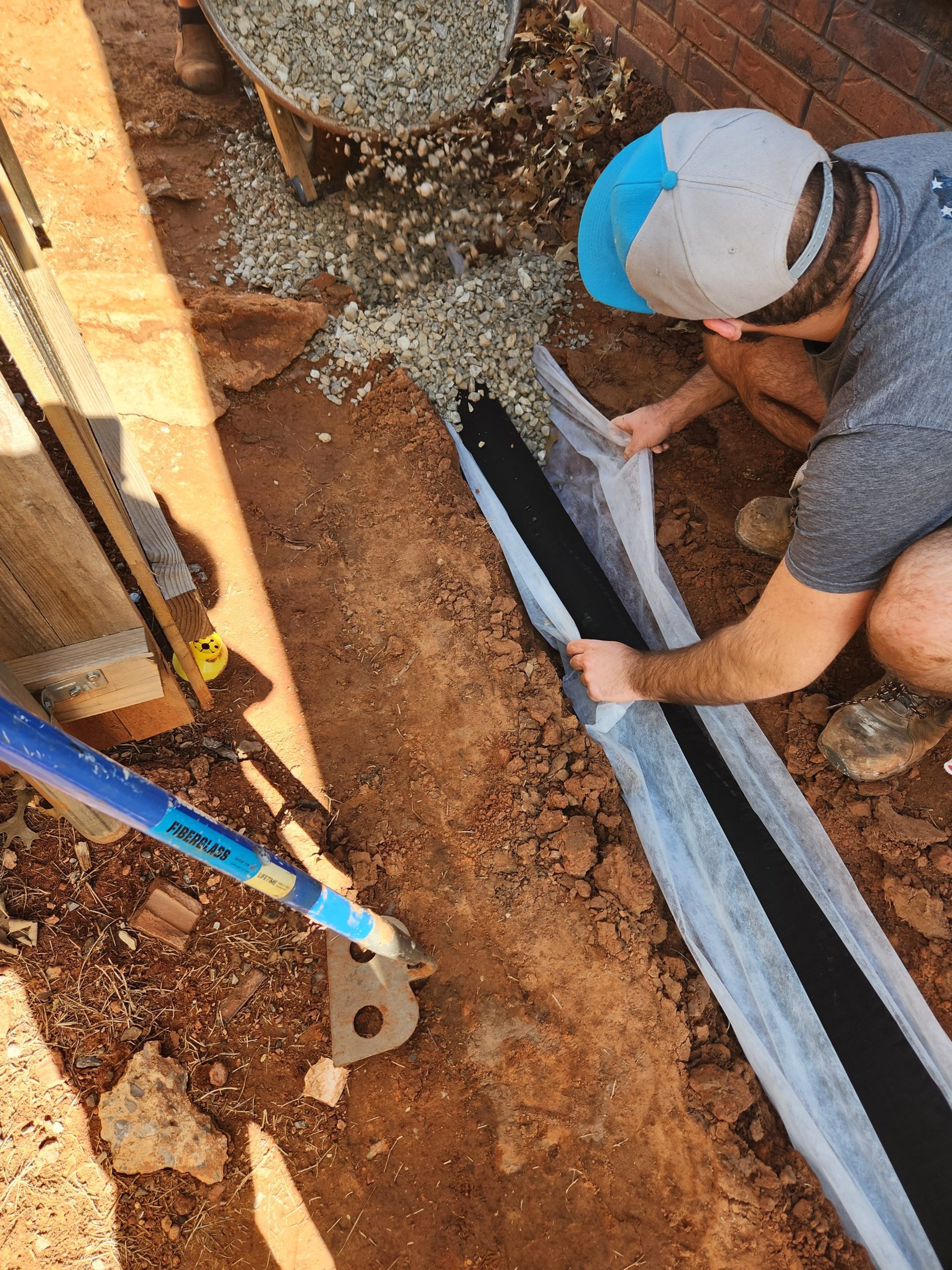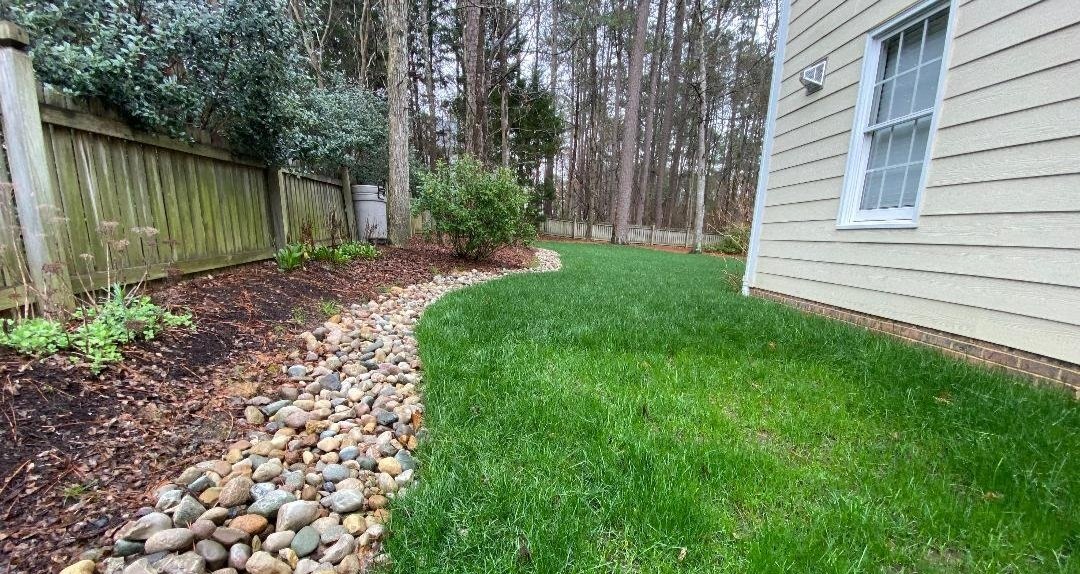How a French Drainpipe Can Assist Prevent Water Damages in Your Basement
A French drain could be the remedy you need if you're dealing with a damp cellar. This system successfully reroutes water far from your structure, helping to avoid costly damage. Understanding exactly how it works and acknowledging the signs that you need one can make a substantial distinction in your house's security and convenience. However prior to you decide, it's important to discover the benefits and setup process to see if it's the appropriate suitable for your situation
What Is a French Drainpipe?
A French drain is a simple yet reliable solution for handling excess water around your residential or commercial property. It's designed to reroute water away from susceptible areas, like your basement or foundation. Commonly, it contains a trench loaded with crushed rock and a perforated pipeline that collects and networks water. When rainwater or groundwater develops, the drain successfully guides it away, preventing potential damage.You could notice French drains pipes set up along property lines, driveways, or perhaps near your home's foundation. They are available in different sizes and arrangements, making them versatile to various landscapes and drain needs. Installing a French drainpipe can aid you prevent costly repair services and secure your home's structural integrity. A French drainpipe might be the remedy you need if you've been dealing with water pooling or soaked locations in your backyard. It's an aggressive procedure to ensure your home continues to be dry and risk-free from water-related problems.
Just how Does a French Drainpipe Work?
A French drainpipe kicks right into activity to redirect it successfully when water accumulates around your home. This system contains a trench loaded with crushed rock and a perforated pipe near the bottom. The pipe collects excess water from the dirt and networks it far from your foundation.As rain or groundwater seeps into the gravel, it moves via the openings and right into the pipeline. Gravity does the work, drawing the water away from your basement and routing it to a marked drain location, like a storm drain or dry well.You can install a French drain either inside or outside your home. It'll protect against water from merging near your foundation if you pick an exterior setup. An interior drainpipe will certainly capture water that seeps through your basement walls. This effective layout maintains your space dry, permitting you to enjoy your home without the concern of water damages.
Benefits of Installing a French Drain
Setting up a French drain can substantially enhance your home's durability against water damage. You'll take pleasure in reliable water diversion, which helps decrease mold development and secure your residential or commercial property. And also, a well-maintained drainage system can also boost your building's worth.
Effective Water Diversion

Reduced Mold Growth
Because dampness produces an excellent atmosphere for mold and mildew to prosper, reducing water accumulation around your home is important for keeping a healthy and balanced living room. Installing a French drainpipe properly channels excess water away from your foundation, keeping your basement dry. This proactive action greatly decreases humidity levels, making it harder for mold spores to resolve and grow.With much less dampness, you'll find it less complicated to breathe and appreciate a tidy, secure environment. And also, you'll decrease the danger of health and wellness concerns connected with mold and mildew direct exposure, such as allergies and respiratory system issues. By purchasing a French drain, you're taking an essential action towards a mold-free cellar, making sure that your home continues to be a comfy place for you and your family.
Boosted Building Value
A French drainpipe can greatly enhance your property's worth, making it a wise financial investment for homeowners. When potential customers see a properly maintained cellar without water damage, they're more likely to be impressed. This feature not just boosts your home's appeal but also signifies that you have actually taken positive actions to safeguard it. By minimizing the danger of water-related issues, your residential or commercial property ends up being more eye-catching in an open market, commonly causing greater deals. Furthermore, the long-term cost savings on fixings and maintenance can equate right into enhanced equity. Setting up a French drainpipe shows you appreciate your home's integrity, comforting buyers that they're making an audio acquisition. Ultimately, it's an important addition that pays off in even more ways than one.
Indications You Required a French Drain
It's a clear sign that you could need a French drainpipe if you see consistent water accumulation in your backyard or basement. Additionally, a musty smell can suggest trapped wetness, which can lead to larger troubles. Addressing these indicators early can help protect against severe water damages to your home.
Persistent Water Accumulation
When you observe persistent water buildup around your home, it's a clear indication that a French drainpipe could be needed. Water pooling near your foundation can bring about substantial damage in time, including architectural problems and mold growth. You should take note of areas where water appears to collect after hefty rains or snowmelt. It's time to take action if your yard remains soggy for days. In addition, search for indicators of erosion or sloppy spots, as these can suggest poor drainage. Installing a French drainpipe helps reroute water far from your home, shielding your foundation and lowering the threat of water damages. Don't await bigger issues to emerge-- attending to water build-up now can conserve you pricey repairs later.
Musty Odor Presence
Consistent water buildup typically results in even more than just noticeable pooling; it can develop an environment ripe for stuffy odors. If you notice a wet, stale smell in your cellar, it's an indicator that dampness is lingering, typically due to bad drainage. This smell typically suggests mold and mildew or mildew development, which can posture health dangers and harm your valuables. You might find that the scent aggravates during moist weather or after heavy rains. If you're fighting relentless stuffy odors, it's time to assess a French drain. This system reroutes water away from your structure, minimizing dampness levels and combating those undesirable smells. useful link Do not neglect this indication; addressing it without delay can save you from much more extensive water damages down the line.
The Installment Process of a French Drain
Setting up a French drain can be an uncomplicated procedure that considerably boosts your home's water damages prevention. Initially, evaluate the location where you desire to install the drainpipe, guaranteeing it slopes far from your foundation. Next, note the trench's path, which need to have to do with 6-8 inches large and 18-24 inches deep.Excavate the trench, getting rid of dirt as needed. Portland French Drain. As soon as you've got your trench, put down landscape material to avoid soil from blocking the drainpipe. Add a layer of crushed rock at the base. Place a perforated pipe on top of the crushed rock, making certain the holes face downward for efficient drainage.Cover the pipe with even more crushed rock, leaving about 3 inches of area on top. Fold up the landscape fabric over the gravel to safeguard it. Finally, fill in the trench with dirt, condensing it as you go. You have actually currently established a trusted system to reroute water far from your basement!
Upkeep Tips for Your French Drainpipe
A French drainpipe is developed to effectively manage water flow, routine upkeep is important to verify its continued performance. Start by inspecting the drain and its environments for particles or obstructions. Clear any type of leaves, dirt, or debris that could accumulate, particularly after hefty rains.Next, check the outlet for correct drainage. It must route water away from your foundation-- if it doesn't, you might require to change its placement. Additionally, confirm that the gravel surrounding the drain is intact and hasn't resolved over time; this helps maintain proper water flow.Consider scheduling a yearly professional evaluation to capture any kind of concerns early. Resolve them right away to stay clear of larger troubles down the road if you discover any type of signs of water damage or pooling. With a little attention, your French drainpipe can properly secure your basement for several years to find.
Expense Factors To Consider and Long-Term Savings
When taking into consideration a French drain, it's crucial to consider both the preliminary financial investment and the long-term savings it can provide. While the upfront cost might appear significant, assume concerning it as an investment in your house's future. Setting up a French drainpipe usually varies from $1,500 to $5,500, relying on your basement's dimension and the intricacy of the installation.However, this expense can conserve you thousands in possible water damage, mold removal, and structure repair work. By avoiding water build-up, you're additionally securing your home's value and preventing pricey insurance claims. In addition, a completely dry cellar can reduce your energy costs, as dampness can bring about enhanced heating and cooling prices. Ultimately, the peace of mind that comes with understanding your home is secured from water damages is priceless. Take into consideration these factors very carefully to make a knowledgeable decision that profits you in the future.

Regularly Asked Inquiries
Can a French Drain Be Installed in Any Kind Of Sort Of Dirt?
Yes, a French drainpipe can be installed in different dirt kinds, including loam, sand, and clay. Nevertheless, appropriate setup and drainage preparation are important to ensure it functions properly in your certain dirt conditions.
How much time Does a French Drain Last Prior To Requiring Substitute?
A French drain normally lasts around 30 to 40 years with correct setup and maintenance. Variables like dirt type and water circulation can affect its life-span, so keep an eye on its performance.
Can French Drains Pipes Assistance With Backyard Water Drainage Issues?
Yes, French drains can effectively address lawn water drainage concerns. They direct excess water away from problem locations, protecting against pooling and ensuring your landscape stays healthy and balanced. Installing one can greatly enhance your lawn's overall drainage efficiency.
Will a French Drain Impact My Landscaping or Yard?
A French drainpipe can affect your landscaping or yard, particularly if it's set up improperly. You'll intend to make sure it's positioned purposefully to lessen disturbance, maintaining your plants and overall visual while boosting drainage.
Are There Alternatives to French Drains for Basement Water Concerns?
Yes, read this post here there are choices to French drains pipes for cellar water problems. You may take into consideration sump pumps, water-proof layers, or grading your yard to check here redirect water away. Each alternative has its advantages, so examine what suits your demands best. When rainwater or groundwater constructs up, the drainpipe efficiently overviews it away, preventing prospective damage.You could notice French drains set up along property lines, driveways, or also near your home's foundation. Gravity does the work, pulling the water away from your basement and guiding it to an assigned drain area, like a tornado drainpipe or completely dry well.You can mount a French drain either inside or outside your home. By properly transporting water away from your residential property, a French drainpipe can significantly lower the risk of water damages. Setting up a French drainpipe aids reroute water away from your home, securing your structure and decreasing the danger of water damage. Setting up a French drain can be an uncomplicated procedure that substantially boosts your home's water damages prevention.